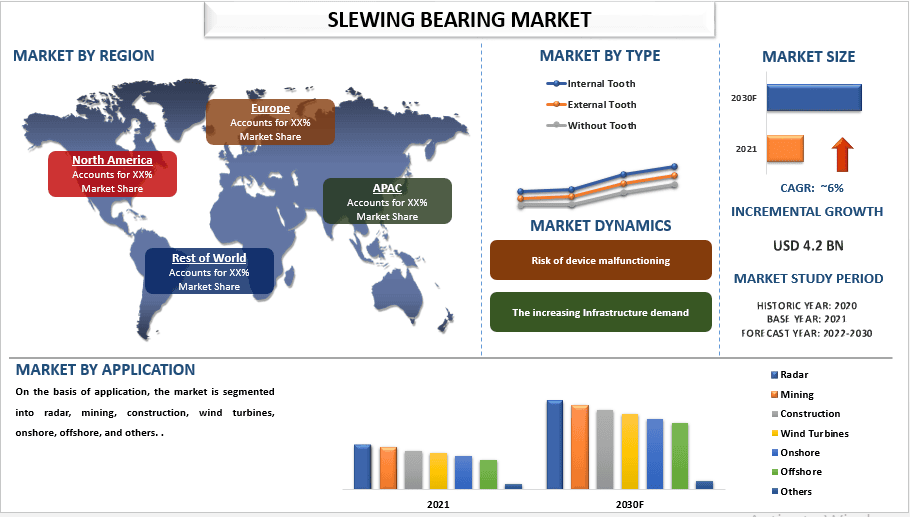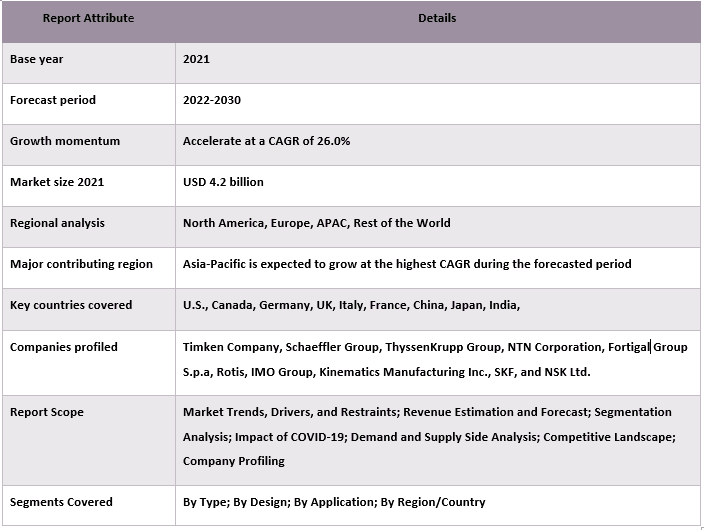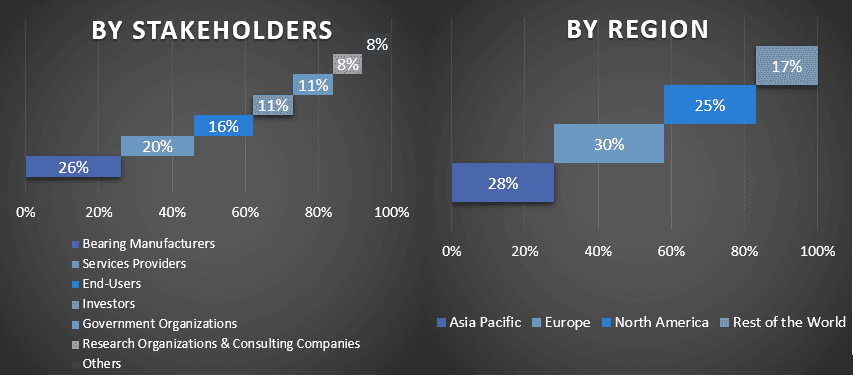- Home
- About Us
- Industry
- Services
- Reading
- Contact Us
Slewing Bearing Market: Current Analysis and Forecast (2022-2030)
Emphasis on Type (Internal Tooth, External Tooth, and Without Tooth) and Application (Cross Roller Slewing Ring Bearing, Bi-angular roller or Taper, Single-row Four Point Contact Ball Slewing Ring Bearing, Four- and Eight-point Contact Ball, Three-row Roller Slewing Ring Bearings, Double-row Ball Slewing Ring Bearings, and Others); Application (Radar, Mining, Construction, Wind Turbines, Onshore, Offshore, and Others); Region/Country.

Slewing Bearing Market was valued at USD 4.2 billion in 2021 & is expected to grow at a CAGR of 6.0% from 2022-2030. Moreover, with increasing awareness about the need and benefits of slewing-bearing technology, spending on product development and R&D activities has increased globally. Burgeoning competition in terms of new players foraying into the slewing-bearing landscape along with evolving governmental policies, growing demand for infrastructure and development in heavy-duty equipment are some of the major drivers for the increased penetration of slewing-bearing devices among consumers, especially in the developed and developing countries. Additionally, the rising investments and product launches in the slewing-bearing market are further contributing to the growth of the market. For instance, in September 2022, SKF India a leading supplier of bearings to auto and other sectors planned to increase investments over the next three years. The investment plan will see the introduction of new products, plant capacity enhancement and increasing localization. The company will usually invest around Rs 150 crore annually as capex.
Some of the major players operating in the market include Timken Company, Schaeffler Group, ThyssenKrupp Group, NTN Corporation, Fortigal Group S.p.a, Rotis, IMO Group, Kinematics Manufacturing Inc., SKF, and NSK Ltd.Several M&As along with partnerships have been undertaken by these players to facilitate customers with hi-tech and innovative products/technologies.
Insights Presented in the Report
“Amongst type, the smart appliances segment held a dominating share of the market in 2021.”
Based on product, the market is segmented into internal tooth, external tooth, and without tooth. Amongst these, the external tooth slewing bearing segment is expected to have significant growth in the slewing bearing market due to the increasing demand for heavy-duty and high-performance bearings in various industries. External tooth slewing bearings are widely used in industries such as construction, mining, and transportation, where heavy loads and high-speed operations are required. These bearings are also known for their high load-carrying capacity, low maintenance, and durability, which makes them an attractive option for heavy-duty applications.
“Amongst application, the wireless slewing bearing technology held the majority share of the market in 2021.”
On the basis of application, the market is segmented into radar, mining, construction, wind turbines, onshore, offshore, and others. Among these, the wind turbines segment of the slewing bearings market is expected to have significant growth due to the increasing demand for renewable energy sources and the need for efficient and reliable wind turbines. Wind turbines use slewing bearings to rotate the blades and track the direction of the wind, which is critical for generating power. As the demand for wind energy continues to grow, so does the need for more efficient and reliable wind turbines, which in turn drives the demand for slewing bearings. Additionally, advancements in technology and materials have led to the development of slewing bearings that are more durable, efficient, and cost-effective, which is also contributing to the growth of this segment.
“Asia-Pacific is expected to grow at the highest CAGR during the forecasted period.”
The Asia Pacific region is expected to have significant growth in the slewing bearing market due to the region’s large population and rapidly growing economy, which is leading to an increase in infrastructure development. This includes the construction of highways, bridges, and other large-scale projects that require heavy duty equipment such as cranes, which use slewing bearings. The region has a supportive government that provides funding for research and development in the manufacturing sector, which has led to the development of new and advanced slewing bearing products.
Slewing Bearing Market Report Coverage

Reasons to buy this report:
- The study includes market sizing and forecasting analysis validated by authenticated key industry experts.
- The report presents a quick review of overall industry performance at one glance.
- The report covers an in-depth analysis of prominent industry peers with a primary focus on key business financials, product portfolios, expansion strategies, and recent developments.
- Detailed examination of drivers, restraints, key trends, and opportunities prevailing in the industry.
- The study comprehensively covers the market across different segments.
- Deep dive regional level analysis of the industry.
Customization Options:
The global slewing bearing market can further be customized as per the requirement or any other market segment. Besides this, UMI understands that you may have your own business needs, hence feel free to connect with us to get a report that completely suits your requirements.
Table of Content
Research Methodology for the Slewing bearing Market Analysis (2022-2030)
Analyzing the historical market, estimating the current market, and forecasting the future market of the global slewing bearing market were the three major steps undertaken to create and analyze the adoption of slewing bearing in major regions globally. Exhaustive secondary research was conducted to collect the historical market numbers and estimate the current market size. Secondly, to validate these insights, numerous findings and assumptions were taken into consideration. Moreover, exhaustive primary interviews were also conducted, with industry experts across the value chain of the global slewing bearing market. Post assumption and validation of market numbers through primary interviews, we employed a top-down/bottom-up approach to forecasting the complete market size. Thereafter, market breakdown and data triangulation methods were adopted to estimate and analyze the market size of segments and sub-segments of the industry pertains to. Detailed methodology is explained below:
Analysis of Historical Market Size
Step 1: In-Depth Study of Secondary Sources:
Detail secondary study was conducted to obtain the historical market size of the slewing bearing market through company internal sources such as annual reports & financial statements, performance presentations, press releases, etc., and external sources including journals, news & articles, government publications, competitor publications, sector reports, third-party database, and other credible publications.
Step 2: Market Segmentation:
After obtaining the historical market size of the slewing bearing market, we conducted a detailed secondary analysis to gather historical market insights and share for different segments & sub-segments for major regions. Major segments are included in the report as type, design, and application. Further country-level analyses were conducted to evaluate the overall adoption of testing models in that region.
Step 3: Factor Analysis:
After acquiring the historical market size of different segments and sub-segments, we conducted a detailed factor analysis to estimate the current market size of the slewing bearing market. Further, we conducted factor analysis using dependent and independent variables such as type, design, and application of the slewing bearing market. A thorough analysis was conducted of demand and supply-side scenarios considering top partnerships, mergers and acquisitions, business expansion, and product launches in the slewing bearing market sector across the globe.
Current Market Size Estimate & Forecast
Current Market Sizing: Based on actionable insights from the above 3 steps, we arrived at the current market size, key players in the global slewing bearing market, and market shares of the segments. All the required percentage shares split, and market breakdowns were determined using the above-mentioned secondary approach and were verified through primary interviews.
Estimation & Forecasting: For market estimation and forecast, weights were assigned to different factors including drivers & trends, restraints, and opportunities available for the stakeholders. After analyzing these factors, relevant forecasting techniques i.e., the top-down/bottom-up approach were applied to arrive at the market forecast for 2028 for different segments and sub-segments across the major markets globally. The research methodology adopted to estimate the market size encompasses:
- The industry’s market size, in terms of revenue (USD) and the adoption rate of the slewing bearing market across the major markets domestically
- All percentage shares, splits, and breakdowns of market segments and sub-segments
- Key players in the global slewing bearing market in terms of products offered. Also, the growth strategies adopted by these players to compete in the fast-growing market
Market Size and Share Validation
Primary Research: In-depth interviews were conducted with the Key Opinion Leaders (KOLs) including Top Level Executives (CXO/VPs, Sales Head, Marketing Head, Operational Head, Regional Head, Country Head, etc.) across major regions. Primary research findings were then summarized, and statistical analysis was performed to prove the stated hypothesis. Inputs from primary research were consolidated with secondary findings, hence turning information into actionable insights.
Split of Primary Participants in Different Regions

Market Engineering
The data triangulation technique was employed to complete the overall market estimation and to arrive at precise statistical numbers for each segment and sub-segment of the global slewing bearing market. data was split into several segments & sub-segments post studying various parameters and trends in the areas of the product, technology, and end-users in the global slewing bearing market.
The main objective of the Global Slewing Bearing Market Study
The current & future market trends of the global slewing bearing market were pinpointed in the study. Investors can gain strategic insights to base their discretion for investments on the qualitative and quantitative analysis performed in the study. Current and future market trends determined the overall attractiveness of the market at a regional level, providing a platform for the industrial participant to exploit the untapped market to benefit from a first-mover advantage. Other quantitative goals of the studies include:
- Analyze the current and forecast market size of the slewing bearing market in terms of value (USD). Also, analyze the current and forecast market size of different segments and sub-segments.
- Segments in the study include areas of the type, design, and application.
- Define and analysis of the regulatory framework for the slewing bearing
- Analyze the value chain involved with the presence of various intermediaries, along with analyzing customer and competitor behaviors of the industry.
- Analyze the current and forecast market size of the slewing bearing market for the major region.
- Major countries of regions studied in the report include Asia Pacific, Europe, North America, and the Rest of the World
- Company profiles of the slewing bearing market and the growth strategies adopted by the market players to sustain in the fast-growing market
- Deep dive regional level analysis of the industry
Related Reports
Customers who bought this item also bought










